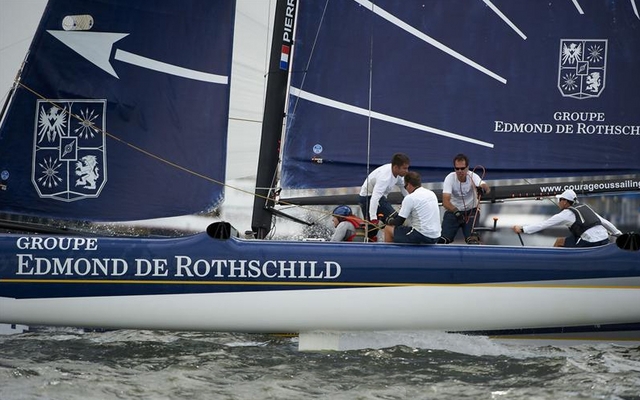During the 4th edition of the Extreme Sailing Series regattas, held in Boston – the first time in America – I had the chance to board Groupe Edmond de Rothschild’s Gitana Extreme and participate in the first race. This increasingly popular one-design series is aptly named: Extreme.
Yves Loday (FRA), Olympic Tornado champion, first thought up the Extreme 40 project about 10 years ago. His vision came from a desire to change the image of sailing as a spectator sport. This tremendous idea was taken up by the OC Thirdpole organization (GBR), which developed and has managed the Extreme Sailing Series since 2007. Everything is ingeniously thought out so that the boats can be admired from shore as they race against each other in the regattas. It’s a superb, entirely free show. The circuit, which went from being a European to a worldwide event in 2011, can be compared to what Formula 1 represents to auto racing.
Fast, extreme navigation
At winds of just 20 knots, an Extreme 40 reaches top speeds of over 30 knots (54 km/h). The maximum recorded speed is 40 knots (74 km/h). For something that could be considered a big dinghy, this is extremely fast. This kind of performance is possible thanks to the all-carbon construction and the use of hydraulics to manage mainsail, foot and downhaul tensions.
The power of G-forces
What impressed me most was the power you feel as soon as the sails are trimmed after coming about. You literally feel pulled toward the stern, as if you were in a motor boat or car. I have never felt that on a boat before. Four men are needed to operate it (+1 guest). A helmsman, one person on hydraulics and trimming the sails, another trimmer who keeps an eye out for possible collisions, and a bowman.
Easy to disassemble
Everything has been designed for long-distance shipping on the international circuit. The hulls, beams, trampoline, and mast (in several parts) can be stored in a container. This can then be loaded on to a truck, train or freighter for international shipping. The organization handles transport, which prevents teams from being held up by shipping delays. It takes 6 hours for 3 men to assemble an Extreme 40. Everything can be done manually without the use of a crane. A trailer for launching the boat is also available. Yes, it’s huge, but scaled for humans to handle nonetheless.
A significant, yet reasonable, budget
Considering the worldwide media payoff of such an athletic sponsorship, the budget required for one season is quite affordable for big corporations. Certainly an individual would need to be in a strong financial position to compete in a full Extreme 40 season.
The price of the catamaran, including sails, fittings and launch, is around $500,000, taxes and delivery not included. For a racing season, count on spending around $1 million to race in the 9 scheduled events, including the team’s salary.
America’s Cup training camp
Since it was decided (in March 2011) that 72-foot catamarans would be used for new Cup events raced over the next 4 years, the Extreme 40 series has been promoted to the level of training camp for challengers in the America’s Cup, whose next edition will be held in San Francisco Bay in 2013. Many skippers and teams racing the Extreme 40 circuit have come from the America’s Cup: Alinghi (SUI) with Tanguy Cariou (FRA), Artemis Racing (SWE) with Terry Hutchinson (USA), and Team New Zealand with Dean Barker. Others more “modestly” boast Olympic champions like Pierre Pennec (FRA) for Groupe Edmond de Rothschild (FRA). Red Bull Extreme Sailing (AUT) has also become a key figure in competition since it became a circuit sponsor. Will they become serious challengers?
I wouldn’t be surprised if San Francisco is chosen as the American stop on the 2012 Extreme 40 season. Coming to Boston was a test for British organization OC Thirdpole. The event’s success surpassed their expectations. We’ll certainly see them in America next year.
Extreme 40
Boat Designer: Yves Loday (FRA) in collaboration with TornadoSport (HOL)
Boat Builder: Marstrom Composites (SWE)
Length: 12.19 metres (40 feet)
Beam: 7.92 metres (26 feet)
Weight: 1,250 kg (2,750 lb)
Mast height: 18.89 metres (62 feet)
Mainsail surface: 75 m2
Jib: 25 m2
Gennaker: 78 m2
Crew: 4 people + 1 guest
Price: 390,000 euros ($544,000) + taxes and shipping
2011 Circuit: Muscat, Oman — Qingdao, China — Istanbul, Turkey — Boston, USA — Cowes, England — Trapani, Italy — Nice, France — Almería, Spain — Singapore

